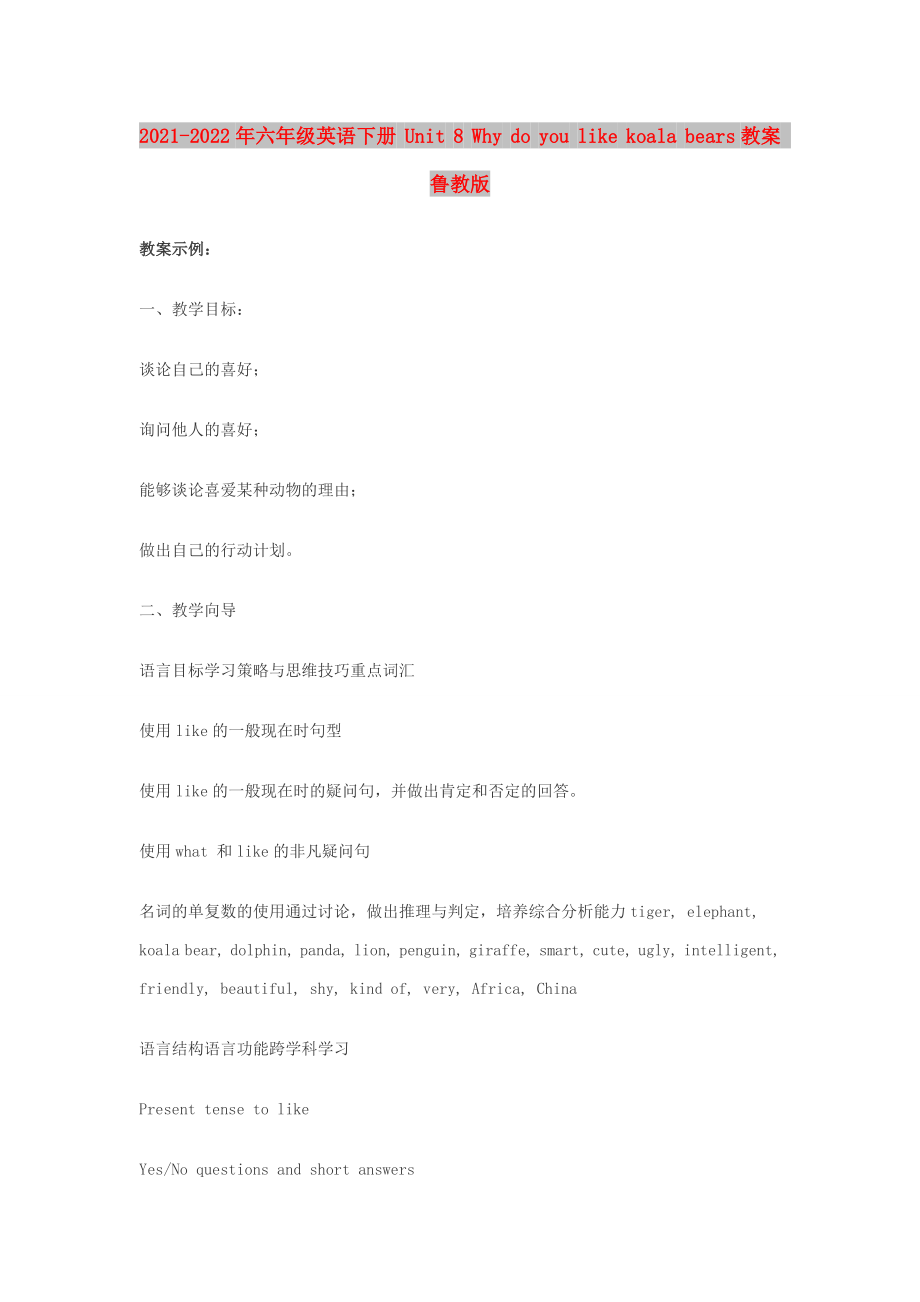《2021-2022年六年級(jí)英語下冊(cè) Unit 8 Why do you like koala bears教案 魯教版》由會(huì)員分享�,可在線閱讀,更多相關(guān)《2021-2022年六年級(jí)英語下冊(cè) Unit 8 Why do you like koala bears教案 魯教版(8頁珍藏版)》請(qǐng)?jiān)谘b配圖網(wǎng)上搜索�。
1、2021-2022年六年級(jí)英語下冊(cè) Unit 8 Why do you like koala bears教案 魯教版
教案示例:
一�、教學(xué)目標(biāo):
談?wù)撟约旱南埠茫?
詢問他人的喜好;
能夠談?wù)撓矏勰撤N動(dòng)物的理由�;
做出自己的行動(dòng)計(jì)劃。
二�、教學(xué)向?qū)?
語言目標(biāo)學(xué)習(xí)策略與思維技巧重點(diǎn)詞匯
使用like的一般現(xiàn)在時(shí)句型
使用like的一般現(xiàn)在時(shí)的疑問句,并做出肯定和否定的回答�。
使用what 和like的非凡疑問句
名詞的單復(fù)數(shù)的使用通過討論,做出推理與判定�,培養(yǎng)綜合分析能力tiger, elephant, koala bear, dolphin, pand
2、a, lion, penguin, giraffe, smart, cute, ugly, intelligent, friendly, beautiful, shy, kind of, very, Africa, China
語言結(jié)構(gòu)語言功能跨學(xué)科學(xué)習(xí)
Present tense to like
Yes/No questions and short answers
And/but
Adjectives of quality
Why do you like koala bears?討論喜好
陳述理由文學(xué):鼓勵(lì)學(xué)生創(chuàng)作�,根據(jù)自己調(diào)查的資料和感受寫出對(duì)保護(hù)動(dòng)物的理解
三、重點(diǎn)
3�、句型
Why do you want to see the pandas?
Because they’re cute.
Why does he like the koala bears?
Because they are kind of interesting.
What animals do you like?
I like penguins. They are cute.
What other animals do you like?
I like dogs, too.
Where are lions from?
They are from Africa.
四、教
4、學(xué)步驟:
Step 1: Lead-in
Show parts of animal’s bodies by slide show, let students guess what animals they are.
Then students show the pictures of all kinds of animals they found before class, and do a brief introduction of the pictures.
Step 2: Task one: make a survey: what animals do your group m
5�、ates want to see?
Listen to the tape and finish Section A, 2a and 2b;
Ask group mates what animals they want to see in a zoo, fill in the chart as below:
NameFavorite animalsWhy
LucyPandas, monkeyscute and friendly; smart and naughty
Presentation: show their pair work
Report: Lucy wants to se
6�、e pandas. She thinks pandas are very cute and friendly…
Step 3: Task two: make decision what animals your group wants to see in a zoo.
1. Choose the most popular three animals in one’s group;
2. Listen to the tape, finish Section B, 2a and 2b;
3. Make a plan when you go to a zoo with your group
7、mates.
Give a dialogue sample:
Boy: Where do you want to go now?
Girl: Let’s see the elephants.
B: The elephants? Why do you like elephants?
G: Oh, they’re interesting. And they are really intelligent.
B: Yes, but they are ugly, too.
G: Oh, Tony! So, where do you want to go?
B: Let’s see the
8�、 pandas. They are kind of cute.
G: Oh, yeah. I love pandas. They’re beautiful. But they are also kind of shy. Where are they?
B: They’re over there on the left, just across from the koala bears.
Step 4: Task three: We are going to the Beijing zoo for Autumn Outing, draw the order your group see a
9、nimals at the zoo and state your reasons.
Group work:
1. Draw a map of the zoo like the picture on P7; (according to the map of Beijing zoo)
2. Mark the order your group see animals;
3. State the reasons like: Lucy, Mary and I like pandas best because they are lovely and beautiful, so we go to s
10�、ee pandas first. Then…
Step 5: Homework: Task:
If you have a wild animal zoo, what animals do you want to put in your zoo?
Draw a map of your zoo and state why you have these wild animals.
教學(xué)點(diǎn)評(píng)及反思:
一、環(huán)節(jié)設(shè)計(jì)思路:
本課以游戲形式的猜動(dòng)物名稱引入�,首先讓學(xué)生通過游戲中的練習(xí),盡快熟悉各種動(dòng)物的英文名稱�。然后導(dǎo)入到三個(gè)鏈狀承接的任務(wù)上。第一個(gè)任務(wù)通過聽力引入本課的第一組重點(diǎn)句型�,即詢
11、問喜歡何種動(dòng)物及其原因�。然后在同學(xué)中做一個(gè)調(diào)查,看看大家都喜歡些什么動(dòng)物以及喜歡的原因�,為第二個(gè)任務(wù)積累資料。任務(wù)二是真實(shí)任務(wù)前的模擬�,讓學(xué)生從大家喜歡的動(dòng)物中挑選兩至三種安排小組去動(dòng)物園的參觀路線。真實(shí)任務(wù)是來源于對(duì)秋游的設(shè)想�,打算組織學(xué)生去北京動(dòng)物園,分小組活動(dòng)�,要求各小組有自己的參觀計(jì)劃,必須明確列及原因�,并根據(jù)地圖說出大致的方位。課堂完成任務(wù)后,課后任務(wù)對(duì)課堂的延伸和鞏固�,因此選擇了學(xué)生較感愛好的野生動(dòng)物問題,同時(shí)兼有美術(shù)和生物學(xué)科的學(xué)習(xí)�,一舉多得。
二�、課后反思:
本課設(shè)計(jì)上思路非常明晰,由潛入深�,教師帶領(lǐng)著學(xué)生一步一個(gè)腳印,漸漸進(jìn)入任務(wù)�,讓學(xué)生非常自然的領(lǐng)會(huì)本課的知識(shí)點(diǎn)。任
12�、務(wù)的設(shè)計(jì)貼近學(xué)生生活,有趣又實(shí)用�,學(xué)生的參與非常熱烈。教師對(duì)課堂的把握非常到位�,收放自如。不足之處在于野生動(dòng)物的話題過于廣泛�,教師可給與適當(dāng)?shù)闹笇?dǎo),提供方向性的資料利于學(xué)生課下任務(wù)的完成�。
附送:
2021-2022年六年級(jí)英語下冊(cè) Unit 9 It's raining單元教學(xué)設(shè)計(jì) 魯教版五四制
教 材 分 析
本單元的核心話題是談?wù)撎鞖夂腿藗冋诟墒裁矗虼巳绾螁柎稹癏ow’s the weather? \What are you/they doing? What’s he/ she doing?是教學(xué)重點(diǎn)�。通過對(duì)本單元的學(xué)習(xí),學(xué)生能掌握本單元出現(xiàn)的表示天氣的形容詞�。問
13、天氣的句式及靈活運(yùn)用現(xiàn)在進(jìn)行時(shí)態(tài)�。
教 學(xué) 目 標(biāo)
1�、知識(shí)目標(biāo):
1)Master the vocabulary.
2)Master and use:How’s the weather?
= What’s the weather like�?It’s raining/ windy…
What are you doing? I’m cooking.
教 學(xué) 重 點(diǎn)
1. 詞匯、詞組搭配
2. 現(xiàn)在進(jìn)行時(shí)的用法�。
3. 談?wù)撎鞖?
教學(xué)難點(diǎn)
1.How’s the weather? It’s….
2. How’s it going
14、? Great.
3.What are you doing? I'm. cooking..
4.How to use “be+doing".
教學(xué)方法
1.本單元的話題與學(xué)生的生活聯(lián)系緊密�,基于此�,創(chuàng)設(shè)生活化的真實(shí)情景,引導(dǎo)學(xué)生在語言學(xué)習(xí)中學(xué)習(xí)語言�,然后再創(chuàng)造性地使用。
2.開展多種活動(dòng)�,給學(xué)生充分的交流空間,加強(qiáng)學(xué)生間的合作學(xué)習(xí)�,并引導(dǎo)學(xué)生進(jìn)行探究學(xué)習(xí)。
學(xué)生情況分析
談?wù)撎鞖馀c我們的日常生活有關(guān)�,加以圖畫形象配合。學(xué)習(xí)起來會(huì)比較直觀易接受�。所以掌握表示天氣的形容詞,動(dòng)詞顯得更為重要�。學(xué)習(xí)“現(xiàn)在進(jìn)行時(shí)“時(shí)師生可隨時(shí)設(shè)置情景, 貼近實(shí)際�,學(xué)生在生動(dòng)活潑的氛圍中掌握教學(xué)內(nèi)容。引導(dǎo)學(xué)生注意區(qū)分一般現(xiàn)在時(shí)與現(xiàn)在進(jìn)行時(shí)的不同�。
單元學(xué)科知識(shí)體系構(gòu)建
課時(shí)分配
The First Period: Section A 1a - 2c
The Second Period: Section A 2d – 3b
The Third Period : Section B 1a – 1e
The Fourth Period: Section B 2a-2c
The Fifth Period: 3a- selfcheck
The Sixth Period: Revision
 2021-2022年六年級(jí)英語下冊(cè) Unit 8 Why do you like koala bears教案 魯教版
2021-2022年六年級(jí)英語下冊(cè) Unit 8 Why do you like koala bears教案 魯教版

